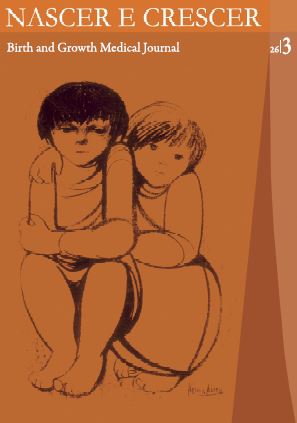MODY, a história de dois irmãos...porque o raro também acontece!
DOI:
https://doi.org/10.25753/BirthGrowthMJ.v26.i3.9582Palavras-chave:
MODY, diabetes mellitus, mutação, gene GCKResumo
Maturity Onset Diabetes of the Young (MODY) é um tipo de diabetes mellitus não insulino-dependente, sem insulinorresistência ou disfunção autoimune das células β pancreáticas. Apresenta história familiar e início antes dos 25 anos. Prevalência estimada de 1-4% dos doentes diabéticos pediátricos.
Apresenta-se o caso clínico de um rapaz, previamente saudável, cuja clínica de hiperglicemia em jejum fez diagnóstico inicial de diabetes mellitus tipo 1. Após conhecimento do diagnóstico de MODY na irmã da linhagem materna, não convivente, procedeu-se ao estudo genético, tendo-se identificado uma mutação em heterozigotia no gene GCK.
A elevada suspeição clínica, habitualmente suportada pela história familiar sugestiva, é o primeiro passo para o correto diagnóstico. No entanto, a necessidade de exames complementares dispendiosos e morosos e a sua prevalência dificultam o seu diagnóstico, impossibilitando desde o início a otimização da terapêutica e do prognóstico, bem como o aconselhamento genético.
Downloads
Referências
Siddiqui K, Musambil M, Nazir N. Maturity onset diabetes of the young (MODY)-History, first case reports and recent advances. Gene. 2014; 555:66-71. doi:10.1016/j.gene.2014.09.062.
Thanabalasingham G, Owen KR. Diagnosis and management of maturity onset diabetes of the young (MODY). British Medical Journal . 2011; 343:d6044. doi:10.1136/bmj.d6044.
Alkorta-Aranburu G, Carmody D, Chenga Y W, Nelakuditia V, Jazzmyne L M, Dickensb T, Das S, Greeley S A W, et al. Phenotypic heterogeneity in monogenic diabetes: The clinical and diagnostic utility of a gene panel-based nextgeneration sequencing approach. Mol Genet Metab. 2014; 113: 315–20. doi:10.1016/j.ymgme.2014.09.007.
Rubio-Cabezas O, Hattersley AT, Njolstad PR, Mlynarski W, Ellard S, Whiw N, et al. The diagnosis and management of monogenic diabetes in children and adolescents. Pediatr Diabetes. 2014; 15:47-64.
Pihoker C, Gilliam LK, Ellard S, Dabelea D, Davis C, Dolan LM, et al. Prevalence, Characteristics and Clinical Diagnosis of Maturity Onset Diabetes of the Young Due to Mutations in HNF1A, HNF4A, and Glucokinase: Results From the SEARCH for Diabetes in Youth. J Clin Endocrinol Metab. 2013: 98: 4055–62. doi:10.1210/jc.2013-1279.
Nobre EL, Lopes LO, Miranda A, Pragosa M, Jácome de Castro J. Mature Onset Diabetes of the Young. Acta Médica Portuguesa. 2002; 15: 435-9.
Weinreich SS, Bosma A, Henneman L, Rigter T, Spruijt CMJ, Grimbergen AJ, et al. A decade of molecular genetic testing for MODY: retrospective study of utilisation in the Netherlands. Eur J Hum Genetics. 2015; 23: 29-33.
Shields BM, Hicks S, Shepherd MH, Colclough K, Hattersley AT, Ellard S. Maturity-onset diabetes of the young (MODY): How many cases are we missing? Diabetologia. 2010; 53:2504-8.
Pinelli M, Acquaviva F, Barbetti F, Caredda E, Cocozza S, Delvecchio M, et al. Identification of candidate children for maturity-onset diabetes of the young type 2 (MODY2) gene testing: A seven-item clinical flowchart (7-iF). PLoS One. 2013; 8:e79933. doi:10.1371/journal.pone.0079933.
Shammas C, Neocleous V, Phelan MM, Lian LY, Skordis N, Phylactou LA. A report of 2 new cases of MODY2 and review of the literature: Implications in the search for type 2 Diabetes drugs. Metabolism. 2013; 62:1535-42. doi:10.1016/j.metabol.2013.06.007.
Owen KR, Thanabalasingham G, James TJ, Karpe F, Farmer AJ, McCarthy MI, et al. Assessment of high-sensitivity C-reactive protein levels as diagnostic discriminator of maturity-onset diabetes of the young due to HNF1A mutations. Diabetes Care. 2010; 33: 1919-24. doi:10.2337/dc10-0288.
Lorini R, Klersy C, D’Annunzio G, Massa O, Minuto N, Iafusco D, et al. Maturity-Onset Diabetes of the Young in Children With Incidental Hyperglycemia: A multicenter Italian study of 172 families. Diabetes Care. 2009; 32:1864-6. doi:10.2337/dc08-2018.
Downloads
Ficheiros Adicionais
Publicado
Como Citar
Edição
Secção
Licença
Copyright e Direitos dos Autores
Todos os artigos publicados na Revista Nascer e Crescer – Birth and Growth Medical Journal são de acesso aberto e cumprem os requisitos das agências de financiamento ou instituições académicas. Relativamente à utilização por terceiros a Nascer e Crescer – Birth and Growth Medical Journal rege-se pelos termos da licença Creative Commons "Atribuição - Uso Não-Comercial - (CC-BY-NC)"".
É da responsabilidade do autor obter permissão para reproduzir figuras, tabelas, etc. de outras publicações.
Juntamente com a submissão do artigo, os autores devem enviar a Declaração de conflito de interesses e formulário de autoria. Será enviado um e-mail ao autor correspondente, confirmando a receção do manuscrito.
Os autores ficam autorizados a disponibilizar os seus artigos em repositórios das suas instituições de origem, desde que mencionem sempre onde foram publicados e de acordo com a licença Creative Commons.


